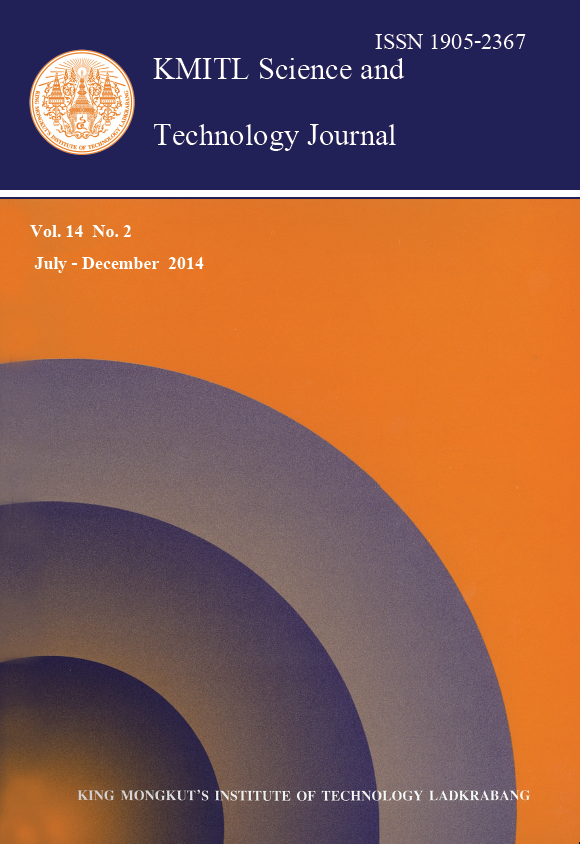Ethanol Production from Sweet Potato by Enzymatic Hydrolyzation and Saccharomyces cerevisiae YRK 017 Fermentation
Main Article Content
Abstract
The aim of this work was to utilize sweet potato for production of bioethanol. Optimal conditions of a-amylase and glucoamylase was carried on hydrolyzation of sweet potato and measurement of reducing sugars. The optimal a-amylase concentration and volume were 0.05% (w/v) and 5 ml, respectively at 90°C for 2 h. Using these conditions, the maximum concentration of reducing sugar was 16.43 g L-1. The optimum glucoamylase concentration and volume were 0.015 (w/v) and 20 ml, respectively at 60°C for 4 h. The concentration of reducing sugar was 41.78 g L-1. After hydrolyzation of sweet potato with these two enzymes at optimal condition and fermented using Saccharomyces cerevisiaeYRK 017 (isolated from Loog-pang), the maximum ethanol concentration of 14.55 g L-1 was achieved after 72 h of separate hydrolysis and fermentation process (SHF). For simultaneous saccharification and fermentation process (SSF), the maximum concentration of ethanol was 12.62 g L-1
Keywords: Sweet potato, Saccharomyces cerevisiae, Bioethanol, Simultaneous saccharification and fermentation
*Corresponding author: E-mail: kodaungj@kmitl.ac.th
Article Details
Copyright Transfer Statement
The copyright of this article is transferred to Current Applied Science and Technology journal with effect if and when the article is accepted for publication. The copyright transfer covers the exclusive right to reproduce and distribute the article, including reprints, translations, photographic reproductions, electronic form (offline, online) or any other reproductions of similar nature.
The author warrants that this contribution is original and that he/she has full power to make this grant. The author signs for and accepts responsibility for releasing this material on behalf of any and all co-authors.
Here is the link for download: Copyright transfer form.pdf
References
[2] He, MX., Feng, H., Bai, F., Li, Y., Liu, X., Zhang, Y. 2009. Direct production of ethanol from raw sweet potato starch using genetically engineered Zymomonas mobilis, Afr. J. Microbiol. Res. 3, 721-726.
[3] Shengjun, W., Zhengyu, J., Qunyi, T and Hanging, C. 2009. Sweet potato : A novel substrate for pollulan production by Aureobasidium pullulans. Carbohydrate polymer, 76, 645-649.
[4] Sankaranarayanam, M. and Mukarukaka, P. 2007. Study on alcohol production from sweet potato. Enzyme and Microbial Technology, 27, 370-380.
[5] Tsai, W.T., Lan, H.F., Lin, D.T. 2008. An analysis of bioetanol utilized as renewable energy in the transportation sector in Taiwan. Revew Sustain Energy Rev., 12, 1364-1382.
[6] Thomsen, A.B., Medina, C., Ahring, B.K. 2003. Biotechnology in ethanol production. In : Larsen, H., Kossmann, J., Petersen, I.S. editors. Risoenergy report 2. Riso National Laboratory, 40-44.
[7] Kurosawa, H., Nomura, N., Tanaka, H. 1988. Ethanol Production from starch by a co-immobilized mixed culture system of Aspergillus awamori and Saccharomyces cerevisiae. Biotechnol. Bioeng., 33, 716-723.
[8] Hwang, W.S., Luen, G.G., Chen, W.H., Men, L.C., Wang, J.B and Kuo, MC. 2007. The current status of the technology development for the cellulosic ethanol at INER. In: Yang, S.S., Sayigh, A.A.M., Lai, C.M.,Chen, S. editors. Development and applications of renewable energy. Taiwan:National Taiwan University, p.35.
[9] Nikolic, S., Mojovic, L., Rakin, M. and Pejin, D. 2009. Bioethanol production from corn meal by simultaneous enzymatic saccharification and fermentation with immobilized cell of Saccharomyces cerevisiae var. ellipsoideus. Fuel. 88, 1602-1607.
[10] Rattanapreedakul, W. 2006. Study on fungi and yeast isolated from Look-pang in comparison with pure culture for sato production. KMITL Science and Technology Journal, 10, 12-18.
[11] Nelson, N. 1944. A photometric adaptation of the somogyi method for the determination of glucose. Journal of biological Chemistry. 153, 375-380.
[12] Saha, B.C. and Cotta, M.A. 2006. Ethanol production from alkaline peroxide pretreated enzymatically saccharified wheat straw.Biotechnol. Prog., 22, 449-453.
[13] Ohgren, K., Bura, R., Lesnicki, G., Saddler, J. and Zacchi, G. 2007. A comparison between simultaneous saccharidication and fermentation and separated hydrolysis and fermentation using steam-pretreated corn stover. Process Biochemistry, 42, 834-839.


